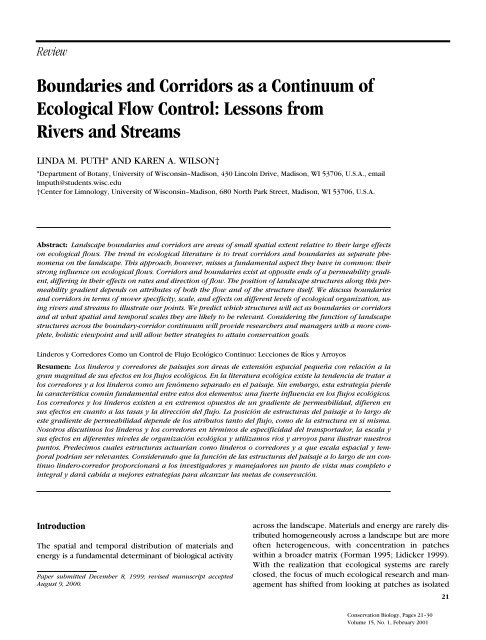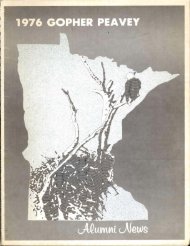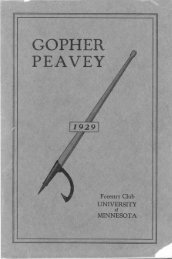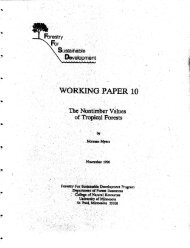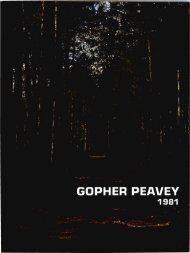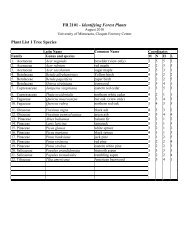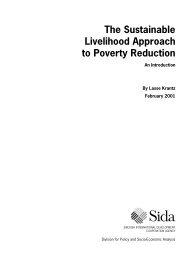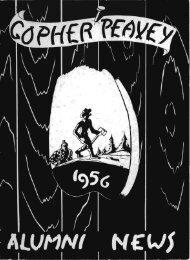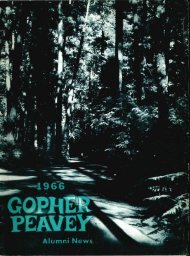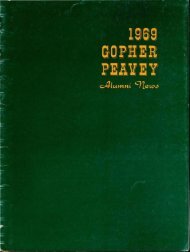Boundaries and Corridors as a Continuum of Ecological Flow Control
Boundaries and Corridors as a Continuum of Ecological Flow Control
Boundaries and Corridors as a Continuum of Ecological Flow Control
You also want an ePaper? Increase the reach of your titles
YUMPU automatically turns print PDFs into web optimized ePapers that Google loves.
Review<br />
<strong>Boundaries</strong> <strong>and</strong> <strong>Corridors</strong> <strong>as</strong> a <strong>Continuum</strong> <strong>of</strong><br />
<strong>Ecological</strong> <strong>Flow</strong> <strong>Control</strong>: Lessons from<br />
Rivers <strong>and</strong> Streams<br />
LINDA M. PUTH* AND KAREN A. WILSON†<br />
*Department <strong>of</strong> Botany, University <strong>of</strong> Wisconsin–Madison, 430 Lincoln Drive, Madison, WI 53706, U.S.A., email<br />
lmputh@students.wisc.edu<br />
†Center for Limnology, University <strong>of</strong> Wisconsin–Madison, 680 North Park Street, Madison, WI 53706, U.S.A.<br />
Abstract: L<strong>and</strong>scape boundaries <strong>and</strong> corridors are are<strong>as</strong> <strong>of</strong> small spatial extent relative to their large effects<br />
on ecological flows. The trend in ecological literature is to treat corridors <strong>and</strong> boundaries <strong>as</strong> separate phenomena<br />
on the l<strong>and</strong>scape. This approach, however, misses a fundamental <strong>as</strong>pect they have in common: their<br />
strong influence on ecological flows. <strong>Corridors</strong> <strong>and</strong> boundaries exist at opposite ends <strong>of</strong> a permeability gradient,<br />
differing in their effects on rates <strong>and</strong> direction <strong>of</strong> flow. The position <strong>of</strong> l<strong>and</strong>scape structures along this permeability<br />
gradient depends on attributes <strong>of</strong> both the flow <strong>and</strong> <strong>of</strong> the structure itself. We discuss boundaries<br />
<strong>and</strong> corridors in terms <strong>of</strong> mover specificity, scale, <strong>and</strong> effects on different levels <strong>of</strong> ecological organization, using<br />
rivers <strong>and</strong> streams to illustrate our points. We predict which structures will act <strong>as</strong> boundaries or corridors<br />
<strong>and</strong> at what spatial <strong>and</strong> temporal scales they are likely to be relevant. Considering the function <strong>of</strong> l<strong>and</strong>scape<br />
structures across the boundary-corridor continuum will provide researchers <strong>and</strong> managers with a more complete,<br />
holistic viewpoint <strong>and</strong> will allow better strategies to attain conservation goals.<br />
Linderos y Corredores Como un <strong>Control</strong> de Flujo Ecológico Continuo: Lecciones de Ríos y Arroyos<br />
Resumen: Los linderos y corredores de paisajes son áre<strong>as</strong> de extensión espacial pequeña con relación a la<br />
gran magnitud de sus efectos en los flujos ecológicos. En la literatura ecológica existe la tendencia de tratar a<br />
los corredores y a los linderos como un fenómeno separado en el paisaje. Sin embargo, esta estrategia pierde<br />
la característica común fundamental entre estos dos elementos: una fuerte influencia en los flujos ecológicos.<br />
Los corredores y los linderos existen a en extremos opuestos de un gradiente de permeabilidad, difieren en<br />
sus efectos en cuanto a l<strong>as</strong> t<strong>as</strong><strong>as</strong> y la dirección del flujo. La posición de estructur<strong>as</strong> del paisaje a lo largo de<br />
este gradiente de permeabilidad depende de los atributos tanto del flujo, como de la estructura en sí misma.<br />
Nosotros discutimos los linderos y los corredores en términos de especificidad del transportador, la escala y<br />
sus efectos en diferentes niveles de organización ecológica y utilizamos ríos y arroyos para ilustrar nuestros<br />
puntos. Predecimos cuales estructur<strong>as</strong> actuarían como linderos o corredores y a que escala espacial y temporal<br />
podrían ser relevantes. Consider<strong>and</strong>o que la función de l<strong>as</strong> estructur<strong>as</strong> del paisaje a lo largo de un continuo<br />
lindero-corredor proporcionará a los investigadores y manejadores un punto de vista m<strong>as</strong> completo e<br />
integral y dará cabida a mejores estrategi<strong>as</strong> para alcanzar l<strong>as</strong> met<strong>as</strong> de conservación.<br />
Introduction<br />
The spatial <strong>and</strong> temporal distribution <strong>of</strong> materials <strong>and</strong><br />
energy is a fundamental determinant <strong>of</strong> biological activity<br />
Paper submitted December 8, 1999; revised manuscript accepted<br />
August 9, 2000.<br />
across the l<strong>and</strong>scape. Materials <strong>and</strong> energy are rarely distributed<br />
homogeneously across a l<strong>and</strong>scape but are more<br />
<strong>of</strong>ten heterogeneous, with concentration in patches<br />
within a broader matrix (Forman 1995; Lidicker 1999).<br />
With the realization that ecological systems are rarely<br />
closed, the focus <strong>of</strong> much ecological research <strong>and</strong> management<br />
h<strong>as</strong> shifted from looking at patches <strong>as</strong> isolated<br />
Conservation Biology, Pages 21–30<br />
Volume 15, No. 1, February 2001<br />
21
22<br />
<strong>Boundaries</strong> <strong>and</strong> <strong>Corridors</strong> Puth & Wilson<br />
entities on the l<strong>and</strong>scape to examining the connections<br />
among such patches (Gosz 1991; Holl<strong>and</strong> & Risser 1991;<br />
Wiens 1992; Anderson & Danielson 1997; Polis et al.<br />
1997). Materials <strong>and</strong> energy are <strong>of</strong>ten packaged <strong>as</strong> organisms<br />
but may also flow across the l<strong>and</strong>scape <strong>as</strong> organic<br />
<strong>and</strong> inorganic matter (e.g., limiting nutrients). To underst<strong>and</strong><br />
the flow <strong>of</strong> materials <strong>and</strong> energy among patches<br />
on the l<strong>and</strong>scape, it is necessary to consider the boundaries<br />
that delimit ecological patches <strong>and</strong> the channelized<br />
routes, or corridors, by which materials <strong>of</strong>ten move.<br />
Here, we define a boundary <strong>as</strong> an area <strong>of</strong> sharp gradients<br />
in ecological flows that slows or redirects flows <strong>of</strong><br />
organisms, matter, or energy between patches (Wiens et<br />
al. 1985) <strong>and</strong> a corridor <strong>as</strong> a structure that channelizes<br />
<strong>and</strong> directs the flow <strong>of</strong> organisms, materials, or energy<br />
between patches. Corridor structures may be permanent<br />
or temporary, stationary or mobile, but all limit the<br />
possible paths a mover may take relative to those possible<br />
in adjacent patches. L<strong>and</strong>scape boundaries <strong>and</strong> corridors<br />
represent critical zones <strong>of</strong> interaction, mediating<br />
fluxes between l<strong>and</strong>scape patches by modifying or maintaining<br />
ecological flows.<br />
As interfaces between l<strong>and</strong>scape patches, <strong>and</strong> therefore<br />
places <strong>of</strong> strong biotic <strong>and</strong> abiotic interactions (di<br />
C<strong>as</strong>tri et al. 1988), boundaries <strong>and</strong> corridors have disproportionately<br />
large influences on l<strong>and</strong>scape functions<br />
(e.g., population, community, <strong>and</strong> ecosystem processes)<br />
beyond what their relative area on the l<strong>and</strong>scape would<br />
suggest. They are essential for ecosystem function <strong>and</strong>,<br />
by virtue <strong>of</strong> their small but critical area, are vulnerable to<br />
modification by humans (Naiman & Décamps 1997). With<br />
accelerated human alteration <strong>of</strong> the l<strong>and</strong>scape, boundaries<br />
<strong>and</strong> corridors have been lost, modified, or created<br />
in many ecosystems (Loney & Hobbs 1991; Forman<br />
1995). These transformations have disrupted natural<br />
flows that formerly occurred within ecosystems, communities,<br />
<strong>and</strong> populations (Harris & Scheck 1991) <strong>and</strong><br />
have created new ones (Bennett 1991). Forests have<br />
been subdivided into isolated woodlots set in a matrix <strong>of</strong><br />
agricultural l<strong>and</strong> (Burgess & Sharpe 1981), rivers have<br />
been blocked by hydroelectric dams (Magnuson 1978;<br />
Holmquist et al. 1998; Jansson et al. 2000), <strong>and</strong> canal systems<br />
link previously isolated waterways (Mills et al.<br />
1993). Even in national parks <strong>and</strong> other protected are<strong>as</strong>,<br />
high-use trails <strong>and</strong> roads connect the exterior <strong>and</strong> interior<br />
portions <strong>of</strong> many remaining forests (Benninger-Truax et al.<br />
1992; Tyser & Worley 1992; Parendes & Jones 2000;<br />
Trombulak & Frissel 2000).<br />
Although both boundaries <strong>and</strong> corridors regulate the<br />
flow <strong>of</strong> matter, organisms, <strong>and</strong> energy between l<strong>and</strong>scape<br />
patches, researchers <strong>and</strong> managers treat boundaries <strong>and</strong><br />
corridors <strong>as</strong> separate <strong>and</strong> unrelated structures on the l<strong>and</strong>scape.<br />
This treatment misses the relationship <strong>of</strong> boundaries<br />
to corridors <strong>as</strong> opposite ends <strong>of</strong> a gradient <strong>of</strong> permeability<br />
to these flows. The position along this range <strong>of</strong><br />
permeability for a single structure is a function <strong>of</strong> char-<br />
Conservation Biology<br />
Volume 15, No. 1, February 2001<br />
acteristics <strong>of</strong> both the ecological flow <strong>and</strong> <strong>of</strong> the structure<br />
itself. The function <strong>of</strong> a structure on the l<strong>and</strong>scape<br />
depends on its regional context (Lidicker 1999), the gradients<br />
<strong>of</strong> ecological flows between patches, <strong>and</strong> the organisms,<br />
materials, <strong>and</strong> energy that interact with the<br />
l<strong>and</strong>scape structure (Naiman & Décamps 1997; Lidicker<br />
1999). Both boundaries <strong>and</strong> corridors modify ecological<br />
flows, boundaries by stopping <strong>and</strong> redirecting flows <strong>and</strong><br />
corridors by channelizing them, but a single structure<br />
can serve <strong>as</strong> both a corridor <strong>and</strong> a boundary, depending<br />
on the flow. Because a given l<strong>and</strong>scape structure can act<br />
<strong>as</strong> both a boundary <strong>and</strong> a corridor for ecological flows,<br />
managers <strong>and</strong> researchers need to account for a multiplicity<br />
<strong>of</strong> l<strong>and</strong>scape functions for any one structure. As<br />
humans create new boundaries <strong>and</strong> corridors <strong>and</strong> modify<br />
“natural” ones, it becomes incre<strong>as</strong>ingly important that<br />
managers <strong>and</strong> researchers carefully consider the multiple<br />
roles <strong>of</strong> these l<strong>and</strong>scape structures in ecological flows<br />
<strong>and</strong> ecosystem functions.<br />
We review the differences <strong>and</strong> similarities between<br />
corridors <strong>and</strong> boundaries, concentrating on their permeability<br />
to ecological flows <strong>and</strong> their effects on the direction<br />
<strong>of</strong> these flows. We use streams to illustrate many <strong>of</strong><br />
our points, with occ<strong>as</strong>ional examples from terrestrial or<br />
other aquatic systems. Because we discuss flows including<br />
but not limited to those <strong>of</strong> organisms, we use the<br />
term mover to denote biotic or abiotic matter or energy<br />
that moves across the l<strong>and</strong>scape under its own power or<br />
is carried by vectors. We define a vector <strong>as</strong> biotic or abiotic<br />
matter that actively transports a mover (Forman &<br />
Godron 1981). Vectors are distinguished by the ability to<br />
move materials or energy against gradients (Wiens et al.<br />
1985) or accelerate material <strong>and</strong> energy along gradients.<br />
Traditional Views <strong>of</strong> L<strong>and</strong>scape <strong>Corridors</strong><br />
<strong>and</strong> <strong>Boundaries</strong><br />
<strong>Corridors</strong><br />
Scientists <strong>and</strong> managers historically have viewed ecological<br />
corridors <strong>as</strong> structures that facilitate the movement<br />
<strong>of</strong> game between forested remnants in agricultural l<strong>and</strong>scapes<br />
(Edminster 1938; Lewis 1964). The archetypal<br />
corridor is linear (Saunders & Hobbs 1991; Hobbs 1992),<br />
spatially continuous (Bennett 1990; Loney & Hobbs 1991),<br />
terrestrial, <strong>and</strong> comprised <strong>of</strong> forest vegetation (Hobbs<br />
1992). Thus, corridors have been seen primarily <strong>as</strong> facilitators<br />
<strong>of</strong> vertebrate dispersal <strong>and</strong> gene exchange (Aars &<br />
Ims 1999). Operating under these <strong>as</strong>sumptions, scientists<br />
have mainly studied the use <strong>of</strong> corridors by birds (Anderson<br />
et al. 1977; Dmowski & Kozakiewicz 1990) <strong>and</strong> small<br />
mammals (Farhig & Merriam 1985; Bennett 1990; Merriam<br />
& Lanoue 1990; Hobbs 1992; Aars & Ims 1999), <strong>of</strong>ten<br />
in agricultural matrices. The characteristics <strong>of</strong> this<br />
type <strong>of</strong> corridor, however, are violated by other movers
Puth & Wilson <strong>Boundaries</strong> <strong>and</strong> <strong>Corridors</strong><br />
such <strong>as</strong> aquatic organisms (Fr<strong>as</strong>er et al 1999; Micheli &<br />
Peterson 1999), nutrients, or by migratory birds that<br />
jump over unsuitable habitat (Date et al. 1991; Forman<br />
1995). Thus, it is necessary to recognize the traditional<br />
definition <strong>as</strong> a special c<strong>as</strong>e <strong>of</strong> a more general concept <strong>of</strong><br />
corridor that allows for various configurations but stresses<br />
movement over form.<br />
<strong>Boundaries</strong><br />
Historically, scientists <strong>and</strong> managers have recognized<br />
l<strong>and</strong>scape boundaries more for their structural distinctions<br />
on the l<strong>and</strong>scape than for their role in l<strong>and</strong>scape<br />
function. Botanists noticed boundaries between plant <strong>as</strong>sociations,<br />
<strong>as</strong> described by the “tension zone” <strong>of</strong> Clements<br />
(1905), <strong>and</strong> vegetation structure continues to be<br />
the primary identifying attribute <strong>of</strong> l<strong>and</strong>scape boundaries<br />
(Risser 1995). Game managers such <strong>as</strong> Aldo Leopold<br />
(1933) recognized the use <strong>of</strong> forest-field edges by<br />
many game species, <strong>and</strong> edge creation w<strong>as</strong> st<strong>and</strong>ard<br />
wildlife management practice for many years (Alverson<br />
et al. 1988). The convergence <strong>of</strong> two or more distinct<br />
communities at l<strong>and</strong>scape boundaries is believed to incre<strong>as</strong>e<br />
the diversity <strong>of</strong> species. <strong>Boundaries</strong> may also augment<br />
the number <strong>of</strong> edge-specialized species by providing<br />
appropriate habitat (e.g., edge effects: Odum 1971;<br />
Harris 1988; Reese & Ratti 1988; Yahner 1988; Lidicker<br />
1999). With the exception <strong>of</strong> those directly interested in<br />
edge species, however, most researchers have found homogeneous<br />
patches on the l<strong>and</strong>scape much e<strong>as</strong>ier to<br />
study than the dynamic boundaries that separate them<br />
<strong>and</strong> have focused primarily on what occurred within<br />
boundaries, rather than on the effects <strong>of</strong> these structures<br />
on their l<strong>and</strong>scape matrix (Lidicker 1999).<br />
Functional Views <strong>of</strong> <strong>Corridors</strong> <strong>and</strong> <strong>Boundaries</strong><br />
<strong>Corridors</strong><br />
<strong>Corridors</strong> function to channel <strong>and</strong> incre<strong>as</strong>e the rate <strong>of</strong><br />
flow <strong>of</strong> whatever is moving along them relative to the<br />
diffuse flow <strong>of</strong> the same mover in the surrounding matrix<br />
(Haddad 1999). They link patches but in structurally<br />
diverse ways <strong>and</strong> at various scales, depending on the<br />
mover (Forman 1995). The key components <strong>of</strong> the definition<br />
<strong>of</strong> a corridor are channelization <strong>and</strong> movement.<br />
For a structure to operate <strong>as</strong> a corridor, something must<br />
travel along it (Lidicker 1999), but along a path more restricted<br />
than those available in a patch or the matrix. For<br />
an organism to perceive a stream <strong>as</strong> a corridor, it would<br />
need to travel along it (rather than merely utilize the<br />
stream <strong>as</strong> habitat) much more readily than through the<br />
surrounding l<strong>and</strong>scape. The movers may be organisms<br />
but also will <strong>of</strong>ten be disturbances, genetic information,<br />
nutrients, or water (Simberl<strong>of</strong>f & Cox 1987; Hobbs 1992;<br />
Simberl<strong>of</strong>f et al. 1992; Hess 1994; Haddad 1999). In addition<br />
to providing avenues for movement for a particular<br />
mover, corridors for a particular mover may function <strong>as</strong><br />
barriers, habitat, sources, or sinks for others (Forman<br />
1983, 1991, 1995; Fr<strong>as</strong>er et al. 1999). Historically, researchers<br />
have studied the use <strong>of</strong> corridors by mammals <strong>and</strong><br />
birds (Haddad 1999), although many c<strong>as</strong>es <strong>of</strong> corridor<br />
use by plants <strong>and</strong> invertebrates have been documented<br />
in recent years (Benninger-Truax et al. 1992; Covich et<br />
al. 1996; Johansson et al. 1996; Haddad 1999; Micheli &<br />
Peterson 1999; Parendes & Jones 2000).<br />
Linear, continuous corridors are e<strong>as</strong>y to conceptualize<br />
<strong>and</strong> are appropriate for the movement <strong>of</strong> some movers,<br />
but they do not encomp<strong>as</strong>s all possible corridor configurations.<br />
As defined above, corridors may take various<br />
configurations (Forman 1991, 1995; Soulé & Gilpin 1991),<br />
including those discontinuous in space or time for a particular<br />
mover (Forman 1983, 1991, 1995; Date et al.<br />
1991; Prevett 1991) <strong>and</strong> perform several ecological functions<br />
(Forman 1983, 1991, 1995). Movers such <strong>as</strong> frugivorous<br />
pigeons (Date et al. 1991) <strong>and</strong> koal<strong>as</strong> (Prevett 1991)<br />
need only stepping stones to move across a l<strong>and</strong>scape<br />
<strong>and</strong> are not concerned with the intervening matrix.<br />
Structures functioning <strong>as</strong> corridors may be temporally<br />
discontinuous if the mover only requires them at certain<br />
times or if they are replaced by other, newly occurring<br />
corridors. A fire, for example, may create a temporary corridor<br />
through a forest interior. A se<strong>as</strong>onal corridor might<br />
be high-water conditions in intermittent streams that allow<br />
the p<strong>as</strong>sage <strong>of</strong> fishes between deep, permanent pools<br />
(Karr 1989; Covich et al 1996). As with other structural<br />
characteristics, the degree <strong>of</strong> continuity <strong>of</strong> a corridor depends<br />
on the requirements <strong>of</strong> the mover (Forman 1995;<br />
Lidicker 1999). The causes <strong>of</strong> this spatial <strong>and</strong> temporal<br />
discontinuity may be abiotic, <strong>as</strong> in the c<strong>as</strong>e <strong>of</strong> ice bridges<br />
during the winter, or biotic, such <strong>as</strong> a newly fallen tree<br />
forming a bridge over a stream. These diverse corridor<br />
structural patterns <strong>and</strong> ecological functions match the<br />
modes <strong>of</strong> transport <strong>and</strong> travel capabilities <strong>of</strong> the various<br />
movers that travel along them (Henein & Merriam 1990;<br />
Forman 1991; Harris & Scheck 1991).<br />
<strong>Boundaries</strong><br />
Because boundaries are the points <strong>of</strong> interaction between<br />
l<strong>and</strong>scape patches, they regulate fluxes across the<br />
l<strong>and</strong>scape <strong>and</strong> are therefore important l<strong>and</strong>scape features<br />
(di C<strong>as</strong>tri et al. 1988; Holl<strong>and</strong> et al. 1991; Hansen &<br />
di C<strong>as</strong>tri 1992; Risser 1995; Lidicker 1999). <strong>Boundaries</strong><br />
are characterized by “the strength <strong>of</strong> the interactions between<br />
ecological systems” [e.g., l<strong>and</strong>scape patches] (Holl<strong>and</strong><br />
1988; Risser 1995; Naiman & Décamps 1997) <strong>and</strong><br />
are locations where the rate or magnitude <strong>of</strong> ecological<br />
flows (nutrients, organisms, matter, energy, or information)<br />
change abruptly relative to those <strong>of</strong> the surrounding<br />
patches (Wiens et al. 1985; Allen & Hoekstra 1992;<br />
23<br />
Conservation Biology<br />
Volume 15, No. 1, February 2001
24<br />
<strong>Boundaries</strong> <strong>and</strong> <strong>Corridors</strong> Puth & Wilson<br />
Naiman & Décamps 1997). By modifying ecological flows<br />
<strong>as</strong> they move across the l<strong>and</strong>scape, boundaries function<br />
to delimit populations, communities, <strong>and</strong> ecosystems.<br />
The effect <strong>of</strong> a boundary depends on characteristics <strong>of</strong><br />
the mover <strong>and</strong> <strong>of</strong> the structure (Naiman & Décamps<br />
1997; Lidicker 1999). For example, because materials accumulate<br />
at them (Forman & Moore 1992), boundaries<br />
such <strong>as</strong> ocean fronts can be sinks for drifting plankton<br />
<strong>and</strong> other organisms (Magnuson et al. 1981; Carr 1987).<br />
<strong>Ecological</strong> boundaries include well-studied forest-field<br />
interfaces (Gates & Gysel 1978; Burgess & Sharpe 1981)<br />
<strong>and</strong> transitions between biomes (Gosz 1992), <strong>as</strong> well <strong>as</strong><br />
less recognized boundaries such <strong>as</strong> those between a decomposing<br />
log <strong>and</strong> the underlying soil or between are<strong>as</strong><br />
<strong>of</strong> high <strong>and</strong> low predation risk.<br />
Researchers have historically described boundaries in<br />
terms <strong>of</strong> their structural form. Structural characteristics<br />
<strong>of</strong> boundaries include size (length, width, <strong>and</strong> depth),<br />
shape (sinuosity, structural complexity), physical composition,<br />
<strong>and</strong> the degree to which they contr<strong>as</strong>t with the<br />
surrounding l<strong>and</strong>scapes (Forman & Moore 1992; Forman<br />
1995; Kol<strong>as</strong>a & Zalewski 1995; Risser 1995; Lidicker<br />
1999). Although researchers have <strong>as</strong>sumed that<br />
boundaries <strong>of</strong> similar structure have the same l<strong>and</strong>scape<br />
function, the evidence for this h<strong>as</strong> been inconclusive.<br />
For instance, researchers studying avian nest predation<br />
across forest-field boundaries found that nest-predation<br />
risk differed between freshly cut edge with no underbrush<br />
<strong>and</strong> old edge with extensive shrubs <strong>and</strong> small<br />
trees (Ratti & Reese 1988). Other researchers working<br />
with similar forest-field boundaries, however, found no<br />
such relationships between the form <strong>of</strong> an edge <strong>and</strong> predation<br />
risk (Yahner et al. 1989). Thus, like corridors,<br />
boundaries are best defined by observed changes in fluxes<br />
<strong>and</strong> processes they influence, rather than by form alone.<br />
The Boundary-Corridor <strong>Continuum</strong><br />
<strong>Boundaries</strong> <strong>and</strong> corridors are linked by their strong effects<br />
on ecological flows, but researchers <strong>and</strong> managers<br />
treat boundaries <strong>and</strong> corridors <strong>as</strong> separate l<strong>and</strong>scape<br />
components. We argue that their charactistics <strong>and</strong> effects<br />
are similar, including species specificity, scale, <strong>and</strong><br />
interactions with levels <strong>of</strong> ecological organizations. Consequently,<br />
their influence on the flow <strong>of</strong> ecological materials<br />
across the l<strong>and</strong>scape is also similar, differentiated<br />
only by their effects on the directionality <strong>and</strong> rates <strong>of</strong><br />
ecological flows.<br />
<strong>Boundaries</strong> <strong>and</strong> corridors constrain flows across the<br />
l<strong>and</strong>scape. They exist at opposite ends <strong>of</strong> a continuum<br />
<strong>of</strong> flow regulation, differing in their effect on rates <strong>and</strong><br />
direction <strong>of</strong> flow (Fig. 1a; Allen & Hoekstra 1992); their<br />
function is analogous to that <strong>of</strong> biological membranes <strong>as</strong><br />
they filter materials (Wiens et al. 1985; Allen & Hoekstra<br />
1992; Forman & Moore 1992; Forman 1995). At one end<br />
Conservation Biology<br />
Volume 15, No. 1, February 2001<br />
Figure 1. <strong>Boundaries</strong> <strong>and</strong> corridors are at the opposite<br />
ends <strong>of</strong> a permeability gradient. (a) <strong>Boundaries</strong><br />
stop <strong>and</strong> change the direction <strong>of</strong> flows, where<strong>as</strong> corridors<br />
channelize <strong>and</strong> change the speed <strong>of</strong> the flows. Permeability<br />
affects not only the rate <strong>of</strong> flow between<br />
patches but also the direction <strong>of</strong> the flow relative to the<br />
patch boundary. (b) For aquatic movers, l<strong>and</strong> between<br />
two lakes may serve <strong>as</strong> an impermeable boundary,<br />
an intermittent stream between the lakes provides<br />
a semipermeable structure, <strong>and</strong> a permanent stream<br />
acts <strong>as</strong> a corridor. (c) In the same system, terrestrial<br />
movers experience the opposite effect: a permanent<br />
stream is impermeable, an intermittent stream is<br />
semipermeable, <strong>and</strong> a strip <strong>of</strong> l<strong>and</strong> is permeable.<br />
<strong>of</strong> the continuum, an impermeable boundary changes the<br />
direction <strong>of</strong> flow by stopping, reflecting, or shuttling<br />
flows along the boundary rather than allowing movement<br />
through the boundary (this shuttling <strong>of</strong> flows transforms<br />
the boundary into a corridor; Forman & Moore 1992;<br />
Naiman <strong>and</strong> Décamps 1997; Haddad 1999). As with biological<br />
membranes, boundaries can have varying degrees <strong>of</strong><br />
permeability to l<strong>and</strong>scape fluxes (Forman 1995; Naiman<br />
& Décamps 1997). An impermeable membrane contains<br />
or redirects flows, where<strong>as</strong> a permeable one changes<br />
the rate <strong>of</strong> flow across the boundary (Forman 1995; Haddad<br />
1999). With incre<strong>as</strong>ing permeability, the change in
Puth & Wilson <strong>Boundaries</strong> <strong>and</strong> <strong>Corridors</strong><br />
flow rate is greater than the change in flow direction. At<br />
the other end <strong>of</strong> the continuum, corridors allow unimpeded<br />
movement across boundaries (or even incre<strong>as</strong>e<br />
the rate <strong>of</strong> flow; Haddad 1999); they are analogous to<br />
pores in a membrane <strong>and</strong> function <strong>as</strong> connectors <strong>of</strong><br />
l<strong>and</strong>scape patches (Allen & Hoekstra 1992). Like boundaries,<br />
corridors once again direct flows, in this c<strong>as</strong>e by<br />
funneling them across boundaries (Haddad 1999). Permeability<br />
<strong>and</strong> directionality are mover-specific characteristics<br />
<strong>of</strong> individual l<strong>and</strong>scape structures (Fig. 1b & 1c). A<br />
logging road, for example, might bar the movement <strong>of</strong><br />
interior forest birds, allow some sunlight to penetrate<br />
the edge <strong>of</strong> the woods, <strong>and</strong> facilitate the flow <strong>of</strong> humans<br />
across the forest. A cattail wetl<strong>and</strong> at the l<strong>and</strong>-water interface<br />
may act <strong>as</strong> an impermeable barrier to terrestrial<br />
animals <strong>and</strong> <strong>as</strong> a semipermeable filter for nutrients that<br />
would otherwise flow directly into the water.<br />
The position <strong>of</strong> a l<strong>and</strong>scape structure along the boundary-corridor<br />
continuum depends on the type <strong>of</strong> mover<br />
<strong>and</strong> its spatial <strong>and</strong> temporal scales <strong>of</strong> movement. We explore<br />
these ide<strong>as</strong> in the context <strong>of</strong> rivers <strong>and</strong> streams,<br />
with occ<strong>as</strong>ional examples from terrestrial systems.<br />
An Example: Streams <strong>and</strong> Rivers<br />
Viewing boundaries <strong>and</strong> corridors <strong>as</strong> a continuum <strong>of</strong><br />
permeability <strong>and</strong> directionality <strong>of</strong> ecological flows gives<br />
l<strong>and</strong>scape features multiple roles in regulating ecological<br />
flows. We examined the boundary-corridor continuum in<br />
the context <strong>of</strong> rivers <strong>and</strong> streams. Theory, such <strong>as</strong> the<br />
river-continuum concept (Vannote et al. 1980), considers<br />
flow along streams <strong>as</strong> unidirectional <strong>and</strong> longitudinal.<br />
Thus, streams operate <strong>as</strong> corridors for the p<strong>as</strong>sive<br />
movement <strong>of</strong> materials <strong>and</strong> nutrients downstream (Forman<br />
1995). But this view <strong>of</strong> streams <strong>and</strong> rivers functionally<br />
isolates streams from the l<strong>and</strong>scapes in which they<br />
occur. A more holistic view sees the stream <strong>as</strong> a dynamic<br />
l<strong>and</strong>scape corridor <strong>and</strong> boundary that strongly affects<br />
the l<strong>and</strong>scape along the boundary-corridor continuum<br />
(e.g., the flood-pulse concept: Junk et al. 1989; Naiman<br />
et al. 1988; Ward 1989; Naiman & Décamps 1997).<br />
Examining boundaries <strong>and</strong> corridors in the context <strong>of</strong><br />
streams <strong>and</strong> rivers <strong>of</strong>fers several advantages to studying<br />
terrestrial systems. Streams <strong>and</strong> rivers are e<strong>as</strong>y to visualize<br />
<strong>as</strong> traditional corridors because they exhibit obvious<br />
directional flow <strong>and</strong> strong linearity (Forman 1995).<br />
They also mirror traditional boundaries in their strong l<strong>and</strong>water<br />
gradients <strong>and</strong> long edges (Forman 1995; Naiman &<br />
Décamps 1997). L<strong>and</strong>-water <strong>and</strong> air-water interfaces tend<br />
to bound aquatic systems more discretely than do many<br />
l<strong>and</strong>-l<strong>and</strong> edges (Forman 1991), making aquatic systems<br />
conceptually e<strong>as</strong>ier to delineate <strong>and</strong> <strong>of</strong>ten e<strong>as</strong>ier to study<br />
(Carpenter et al. 1995). <strong>Flow</strong>ing waters integrate entire<br />
watersheds by combining both terrestrial <strong>and</strong> aquatic <strong>as</strong>pects<br />
<strong>of</strong> the l<strong>and</strong>scape. These characteristics make them<br />
ideal natural laboratories in which to test ecosystem properties<br />
(Allen & Hoekstra 1992; Carpenter et al. 1995).<br />
Mover Specificity<br />
The position <strong>of</strong> a l<strong>and</strong>scape structure on the boundarycorridor<br />
continuum—its function in the l<strong>and</strong>scape—<br />
depends on the movement characteristics <strong>of</strong> individual<br />
movers (Noss 1991; Naiman & Décamps 1997), such that<br />
a single l<strong>and</strong>scape structure may function <strong>as</strong> a boundary,<br />
corridor, or something intermediate (Allen & Hoekstra<br />
1992; Naiman & Décamps 1997). Movers possess a wide<br />
range <strong>of</strong> travel modes: they may walk, run, fly, swim,<br />
crawl, or be carried by vectors. They may be biotic or<br />
abiotic. They may move actively under their own power<br />
or p<strong>as</strong>sively by vectors. These traits combine to produce<br />
an enormous variety in movement characteristics, so<br />
that locating a single stream along the boundary-corridor<br />
continuum is impossible without first identifying the focus<br />
mover (Fig. 1b & 1c).<br />
Active movers, whether abiotic or biotic, may interact<br />
differently with the same l<strong>and</strong>scape structure. For biotic<br />
movers, the effect <strong>of</strong> a boundary or corridor depends on<br />
that organism’s dispersal rate <strong>and</strong> mode, home range, physical<br />
size, <strong>and</strong> the presence or absence <strong>of</strong> predators <strong>and</strong><br />
competitors (Wiens et al. 1985). For abiotic movers, the<br />
effect <strong>of</strong> a corridor or boundary varies with the structure’s<br />
medium (e.g., l<strong>and</strong> or air), the morphometry <strong>of</strong><br />
the boundary or corridor, <strong>and</strong> the rate at which the<br />
mover is traveling. In a similar manner, the p<strong>as</strong>sive transport<br />
<strong>of</strong> materials <strong>and</strong> energy across the l<strong>and</strong>scape by<br />
biotic <strong>and</strong> abiotic vectors depends on the interactions<br />
between the vector <strong>and</strong> the boundary or corridor. For<br />
example, riparian zones <strong>of</strong>ten reduce the water-borne flow<br />
<strong>of</strong> nutrients from terrestrial systems to wetl<strong>and</strong> are<strong>as</strong>,<br />
but overwintering Snow Geese (Chen caerulescens)<br />
<strong>and</strong> S<strong>and</strong>hill Cranes (Grus canadensis) in New Mexico<br />
move ecologically significant amounts <strong>of</strong> nitrogen <strong>and</strong><br />
phosphorus across riparian are<strong>as</strong> from agricultural fields<br />
to wetl<strong>and</strong> roosting are<strong>as</strong> (Post et al. 1998). As se<strong>as</strong>onally<br />
important vectors for the nutrients, the birds function <strong>as</strong><br />
a corridor connecting the two are<strong>as</strong>. Mover specificity is<br />
a function <strong>of</strong> the movement characteristics <strong>of</strong> whatever<br />
actively travels across the l<strong>and</strong>scape, whether this is a<br />
mover or a vector carrying the mover (Fig. 1b & 1c).<br />
Streams are well-defined corridors for the downstream<br />
movement <strong>of</strong> nutrients, energy, <strong>and</strong> matter; but they<br />
function in many other capacities on the l<strong>and</strong>scape, <strong>as</strong><br />
defined by the mover(s) <strong>of</strong> interest. Streams funnel nutrients<br />
<strong>and</strong> plant propagules ( Johansson et al. 1996;<br />
Parendes & Jones 2000) but tend to redirect the movement<br />
<strong>of</strong> terrestrial rodents, functioning <strong>as</strong> boundaries for<br />
terrestrial organisms (Fig. 1b & 1c; Storm et al. 1976;<br />
Knaapen et al. 1992) <strong>and</strong> flows, such <strong>as</strong> fire. In addition<br />
to their role in transporting flows downstream, streams<br />
<strong>and</strong> rivers also act <strong>as</strong> longitudinal corridors for a multi-<br />
25<br />
Conservation Biology<br />
Volume 15, No. 1, February 2001
26<br />
<strong>Boundaries</strong> <strong>and</strong> <strong>Corridors</strong> Puth & Wilson<br />
tide <strong>of</strong> upstream flows. Spawning salmon move nutrients<br />
upstream from the oceans <strong>and</strong> enrich both the<br />
headwaters <strong>and</strong> forest ecosystems (Donaldson 1967;<br />
Mathisen et al. 1988; Cederholm et al. 1989; Kline et al.<br />
1990; 1993; Schuldt 1995). Most adult airborne aquatic<br />
insects fly in an upstream direction (Müller 1982), <strong>and</strong><br />
many aquatic organisms regularly travel upstream to<br />
spawn or recolonize pools after floods or other local extinction<br />
events (Chapman & Kramer 1991; Meadow &<br />
Matthews 1992; Sheldon & Meffe 1995; Covich et al.<br />
1996). As boundaries, streams separate some terrestrial<br />
mammal populations but not others (Patton et al. 2000).<br />
Scale<br />
Movers <strong>and</strong> vectors interact with the l<strong>and</strong>scape at significantly<br />
different spatial <strong>and</strong> temporal grains <strong>and</strong> extents.<br />
The scale at which movers or vectors encounter the l<strong>and</strong><br />
defines the position <strong>of</strong> a l<strong>and</strong>scape structure along the<br />
boundary-corridor continuum (Wiens & Milne 1989; Noss<br />
1991; Allen & Hoekstra 1992; Holling 1992). For example,<br />
small mammals respond to river <strong>and</strong> canal boundaries<br />
at smaller grains <strong>and</strong> extents than do large mammals<br />
(Knaapen et al 1992). A stream that because <strong>of</strong> its<br />
width represents an insurmountable barrier to a mouse<br />
is mere steps to a deer. To the mouse, the stream is a<br />
boundary limiting its movements; to the deer, the stream<br />
is one <strong>of</strong> many water sources in the matrix <strong>of</strong> streams<br />
<strong>and</strong> forest in which it forages. In a similar manner, a<br />
stream corridor used by a hunting bat will represent a<br />
habitat patch for a stonefly larva that perceives its environment<br />
at the scale <strong>of</strong> meters (Wiens & Milne 1989).<br />
Conversely, the position <strong>of</strong> a l<strong>and</strong>scape structure on<br />
the boundary-corridor continuum changes the scaling <strong>of</strong><br />
a l<strong>and</strong>scape by linking some l<strong>and</strong>scape patches <strong>and</strong> dividing<br />
others. Processes occurring on a l<strong>and</strong>scape composed<br />
<strong>of</strong> patches connected by corridors operate at a<br />
larger scale than on a l<strong>and</strong>scape consisting <strong>of</strong> isolated<br />
patches. These same corridors, may concurrently function<br />
<strong>as</strong> boundaries, however, dividing other l<strong>and</strong>scape<br />
processes. For example, a canal dug between two otherwise<br />
isolated lakes allows the interlake transfer <strong>of</strong> nutrients<br />
<strong>and</strong> organisms; at the same time, it splits the local<br />
terrestrial ecosystem <strong>and</strong> populations (Fig. 1b & 1c).<br />
Through these effects on l<strong>and</strong>scape connectivity, boundaries<br />
<strong>and</strong> corridors delimit ecological systems.<br />
Streams <strong>as</strong> Terrestrial <strong>Boundaries</strong> <strong>and</strong> <strong>Corridors</strong><br />
Streams <strong>and</strong> rivers act <strong>as</strong> boundaries <strong>and</strong> corridors for<br />
terrestrial systems <strong>as</strong> well <strong>as</strong> for aquatic systems. Streams<br />
<strong>and</strong> rivers can partition terrestrial l<strong>and</strong>scapes by isolating<br />
or reducing flows between l<strong>and</strong>scape patches (Knaapen<br />
et al. 1992; Lamborot & Eaton 1997; Patton et al. 2000).<br />
Storm et al. (1976) found that midwestern rivers hindered<br />
the movement <strong>of</strong> red foxes ( Vulpes fulva)<br />
be-<br />
Conservation Biology<br />
Volume 15, No. 1, February 2001<br />
tween populations on opposite banks, with large rivers<br />
providing lower permeability than small ones. Peres et al.<br />
(1996) found that the function <strong>of</strong> rivers in the Amazon<br />
b<strong>as</strong>in <strong>as</strong> boundaries to gene flow for tamarins incre<strong>as</strong>ed<br />
with river size. Rivers may also stop terrestrial processes<br />
such <strong>as</strong> fire (Forman 1995). For nonswimmers, rivers become<br />
impermeable boundaries <strong>and</strong> direct movement<br />
along the river bank, or back into the surrounding matrix.<br />
Many terrestrial animals travel along riparian zones,<br />
using them <strong>as</strong> movement corridors (Forman & Godron<br />
1986), <strong>and</strong> flying organisms such <strong>as</strong> bats hunt above the<br />
river channel (Forman 1995).<br />
Leaky Stream <strong>Boundaries</strong> <strong>as</strong> Connections to<br />
Terrestrial Systems<br />
Streams <strong>and</strong> rivers do more than connect their sources<br />
<strong>and</strong> endpoints; they exhibit “leaky” l<strong>and</strong>-water boundaries,<br />
acting <strong>as</strong> semipermeable filters to lateral flows (Naiman<br />
et al. 1988; Junk et al. 1989; Forman 1995). Floods<br />
transfer nutrients <strong>and</strong> materials from water to l<strong>and</strong> ( Junk<br />
et al. 1989; Power 1995), or from l<strong>and</strong> to water ( Junk et<br />
al. 1989). Biotic movers such <strong>as</strong> beavers (Naiman et al.<br />
1994), emerging aquatic insects ( Jackson & Fisher 1986),<br />
waterfowl (Post et al. 1998), <strong>and</strong> reproducing amphibians<br />
(Seale 1980) connect terrestrial <strong>and</strong> aquatic ecosystems<br />
<strong>and</strong> incre<strong>as</strong>e the permeability <strong>of</strong> the l<strong>and</strong>-water interface<br />
by moving laterally between the terrestrial <strong>and</strong><br />
aquatic systems.<br />
Within-Stream <strong>Boundaries</strong> <strong>and</strong> <strong>Corridors</strong><br />
A continuum <strong>of</strong> boundaries <strong>and</strong> corridors exists within<br />
streams <strong>and</strong> rivers, changing the direction <strong>and</strong> permeability<br />
to flows within the stream or river channel itself<br />
(Naiman et al. 1988; Forman 1995). Dams, culverts, <strong>and</strong><br />
waterfalls (Magnuson 1978; Holmquist et al. 1998; Jansson<br />
et al. 2000), <strong>as</strong> well <strong>as</strong> riffles during periods <strong>of</strong> low water<br />
(Power et al. 1985, Covich et al. 1996) physically<br />
block within-stream movements. Biotic conditions <strong>of</strong> the<br />
stream, such <strong>as</strong> the presence <strong>of</strong> predators or competitors,<br />
limit movers (Bradford et al. 1993; Covich et al 1996;<br />
García-Ramos et al. 2000), <strong>as</strong> do physical factors, including<br />
water velocity, nutrient levels (Dent & Grimm<br />
1999), temperature, dissolved oxygen, <strong>and</strong> water levels.<br />
Reservoirs above dams, for example, tend to have<br />
warmer, slower moving water than that below the dam,<br />
<strong>and</strong> hence different community <strong>as</strong>semblages. In-stream<br />
boundaries may be selectively permeable, <strong>as</strong> in waterfalls<br />
that delimit adult goby populations but allow upstream<br />
movement <strong>of</strong> larval fishes (Radtke & Kinzie 1996), <strong>and</strong><br />
low water conditions that block the movement <strong>of</strong> fishes<br />
between deep pools. Interestingly, within-stream boundaries<br />
such <strong>as</strong> shallow riffles or beaver dams may incre<strong>as</strong>e<br />
the permeability <strong>of</strong> the stream boundary to terrestrial organisms<br />
by incre<strong>as</strong>ing crossing points.
Puth & Wilson <strong>Boundaries</strong> <strong>and</strong> <strong>Corridors</strong><br />
Temporal Variability<br />
Although the function <strong>of</strong> a stream or river along the<br />
boundary-corridor continuum may be relatively permanent,<br />
in other situations its role may be diurnal (tidal rivers),<br />
se<strong>as</strong>onal (floods, droughts, <strong>and</strong> ice), stoch<strong>as</strong>tic (storm<br />
events), ephemeral (temporary log jams), or related to<br />
the life history <strong>of</strong> both movers <strong>and</strong> structures (size-refugia,<br />
successional changes). Water levels in tidal rivers<br />
may fluctuate several meters twice daily. In larger streams<br />
<strong>and</strong> rivers, se<strong>as</strong>onal floods predictably deliver materials<br />
<strong>and</strong> nutrients to lowl<strong>and</strong> are<strong>as</strong> ( Junk et al. 1989). Sensitivity<br />
to fluctuating lotic flow regimes can determine the<br />
inv<strong>as</strong>ion success <strong>of</strong> exotic fish species (Brown & Moyle<br />
1997). Ice allows terrestrial animals to cross large bodies<br />
<strong>of</strong> water (Ferguson et al. 2000). Successional changes<br />
along a corridor may dictate which movers can use it. A<br />
stretch <strong>of</strong> seagr<strong>as</strong>s that functions <strong>as</strong> a corridor allowing<br />
the movement <strong>of</strong> crab predators (Micheli & Peterson<br />
1999) is unlikely to have the same effect when the<br />
shoots are young. A boundary defined by the presence<br />
<strong>of</strong> predators in an adjacent patch will lose its effectiveness<br />
if the mover obtains a size-refuge where it is too<br />
large to be consumed (Werner & Hall 1988).<br />
Interaction between Mover Specificity <strong>and</strong> Scale<br />
Mover specificity <strong>and</strong> scale do not operate in isolation;<br />
rather, they work together to determine the function <strong>of</strong><br />
a river or stream (Fig. 2). The scale <strong>of</strong> a river or stream is<br />
related to its length <strong>and</strong> depth for flows parallel to it <strong>and</strong><br />
to its width <strong>and</strong> depth for flows perpendicular to it. The<br />
scale <strong>of</strong> movers corresponds to their resolution <strong>of</strong> movement,<br />
such <strong>as</strong> step length for terrestrial mammals. If the<br />
width or length <strong>of</strong> a stream is smaller than that at which<br />
a particular mover travels (e.g, moose [ Alces alces]<br />
moving<br />
tens <strong>of</strong> kilometers a day), the mover will not use the<br />
stream <strong>as</strong> an independent l<strong>and</strong>scape structure. If the<br />
width <strong>of</strong> the stream matches the step or jump length <strong>of</strong><br />
the mover (e.g., bobcat [ Lynx rufus]<br />
moving a few kilometers<br />
a day) <strong>and</strong> the mover perceives the stream <strong>as</strong> inhospitable,<br />
then the structure will act <strong>as</strong> a boundary. If<br />
the scale <strong>of</strong> the stream matches that <strong>of</strong> the mover <strong>and</strong><br />
the mover (e.g., anadromous salmon moving a kilometer<br />
a day) recognizes the stream <strong>as</strong> hospitable, the stream<br />
will function <strong>as</strong> a corridor. When the width <strong>of</strong> the<br />
stream is greater than the step length <strong>of</strong> the mover (e.g.,<br />
mice moving tens <strong>of</strong> meters a day) <strong>and</strong> the mover perceives<br />
the structure <strong>as</strong> inhospitable, the structure will<br />
also operate <strong>as</strong> a boundary. If the width <strong>of</strong> the stream is<br />
greater than that moved by the mover in a short period<br />
<strong>of</strong> time <strong>and</strong> the mover recognizes the structure <strong>as</strong> hospitable,<br />
the structure will act <strong>as</strong> habitat (caddisfly moving<br />
tens <strong>of</strong> centimeters a day). This interaction reveals a fundamental<br />
inequity between boundaries <strong>and</strong> corridors:<br />
Figure 2. Scale <strong>and</strong> mover specificity interact to determine<br />
the function <strong>of</strong> a structure. Mover specificity relies<br />
on how well the mover can travel in a specific medium,<br />
such <strong>as</strong> forest or water. This interaction reveals<br />
a major inequity between the conditions that produce<br />
corridors <strong>and</strong> boundaries, which suggests there will be<br />
more boundaries than corridors on the l<strong>and</strong>scape.<br />
more l<strong>and</strong>scape structures fall on the boundary side <strong>of</strong><br />
the boundary-corridor continuum, because more combinations<br />
<strong>of</strong> scale <strong>and</strong> mover specificity lead to a structure<br />
functioning <strong>as</strong> a boundary than <strong>as</strong> a corridor.<br />
Levels <strong>of</strong> <strong>Ecological</strong> Organization<br />
Because streams <strong>and</strong> rivers play numerous roles along<br />
the boundary-corridor continuum, they have effects on<br />
many types <strong>of</strong> ecological entities, including traditional<br />
ecological levels <strong>of</strong> organization. For example, <strong>as</strong> a corridor,<br />
a stream may allow the movement <strong>of</strong> breeding<br />
aquatic organisms or the dispersal <strong>of</strong> juveniles, influencing<br />
populations (Schlosser 1995). If the fish are predatory,<br />
their movement along the stream corridor may<br />
strongly affect stream communities (Covich et al. 1996).<br />
The p<strong>as</strong>sage <strong>of</strong> sediments downstream <strong>and</strong> death <strong>of</strong><br />
anadromous fish upstream influence ecosystem processes<br />
(Mathisen et al. 1988; Schuldt 1995). The pattern<br />
<strong>of</strong> fish movement <strong>and</strong> energy flow up <strong>and</strong> down the<br />
stream is a l<strong>and</strong>scape consideration. Alternatively, the<br />
same stream may separate terrestrial rodent populations<br />
on either stream bank (populations), disconnect competitive<br />
interactions between organisms (communities),<br />
direct the flow <strong>of</strong> nutrients from eroded terrestrial sediments<br />
(ecosystems), <strong>and</strong> prevent fires from crossing<br />
from one bank to the other (l<strong>and</strong>scapes). Changes in the<br />
direction <strong>and</strong> permeability <strong>of</strong> streams <strong>and</strong> rivers will consequently<br />
affect ecological flows important to all levels<br />
<strong>of</strong> ecological organization.<br />
27<br />
Conservation Biology<br />
Volume 15, No. 1, February 2001
28<br />
<strong>Boundaries</strong> <strong>and</strong> <strong>Corridors</strong> Puth & Wilson<br />
Conclusions<br />
<strong>Boundaries</strong> <strong>and</strong> corridors have traditionally been studied<br />
<strong>as</strong> independent l<strong>and</strong>scape structures. B<strong>as</strong>ed on the strong<br />
similarities in l<strong>and</strong>scape function, however, we argue<br />
that boundaries <strong>and</strong> corridors are at polar ends <strong>of</strong> a continuum<br />
b<strong>as</strong>ed on permeability <strong>and</strong> directionality <strong>of</strong> ecological<br />
flows. This viewpoint unites the <strong>of</strong>ten parallel<br />
treatment <strong>of</strong> boundaries <strong>and</strong> corridors <strong>and</strong> emph<strong>as</strong>izes<br />
the fact that a structure on the l<strong>and</strong>scape may act <strong>as</strong> a<br />
boundary or a corridor or may play an intermediate role,<br />
depending on mover specificity <strong>and</strong> temporal <strong>and</strong> spatial<br />
dynamics.<br />
Researchers <strong>and</strong> managers should recognize that these<br />
structures can be ephemeral features on the l<strong>and</strong>scape,<br />
<strong>and</strong>, conversely, that some l<strong>and</strong>scape structures may<br />
not always act <strong>as</strong> boundaries <strong>and</strong> corridors, although they<br />
may look like boundaries <strong>and</strong> corridors. Moreover, the<br />
movers that interact with boundaries <strong>and</strong> corridors may<br />
also be ephemeral, depending on characteristics such <strong>as</strong><br />
life history <strong>and</strong> se<strong>as</strong>onality. The mover-specific qualities<br />
<strong>of</strong> the boundary-corridor continuum underscore the dangers<br />
<strong>of</strong> single-species management in which a structure’s<br />
influence on one mover is emph<strong>as</strong>ized over all others.<br />
Underst<strong>and</strong>ing the similarities between corridors <strong>and</strong><br />
boundaries may help us interpret the movement <strong>of</strong> organisms<br />
across the l<strong>and</strong>scape <strong>and</strong> determine points <strong>of</strong><br />
vulnerability to the spread <strong>of</strong> exotics. A knowledge <strong>of</strong><br />
boundary <strong>and</strong> corridor function may also further the prediction<br />
<strong>of</strong> likely consequences <strong>of</strong> natural disturbances,<br />
anthropogenic perturbations, <strong>and</strong> management actions.<br />
As are<strong>as</strong> <strong>of</strong> strong influence on ecological flows, boundaries<br />
<strong>and</strong> corridors present a challenge to researchers, in<br />
their detection <strong>and</strong> description <strong>and</strong> in their conservation.<br />
Literature Cited<br />
Aars, J., <strong>and</strong> R. A. Ims. 1999. The effect <strong>of</strong> habitat corridors on rates <strong>of</strong><br />
transfer <strong>and</strong> interbreeding between vole demes. Ecology 80: 1648–<br />
1655.<br />
Allen, T. F. H., <strong>and</strong> T. W. Hoekstra. 1992. Toward a unified ecology.<br />
Columbia University Press, New York.<br />
Alverson, W. S., D. M. Waller, <strong>and</strong> S. L. Solheim. 1988. Forests to deer:<br />
edge effects in Northern Wisconsin. Conservation Biology 2: 348–358.<br />
Anderson, G. S., <strong>and</strong> B. J. Danielson. 1997. The effects <strong>of</strong> l<strong>and</strong>scape<br />
composition <strong>and</strong> physiognomy on metapopulation size: the roles<br />
<strong>of</strong> corridors. L<strong>and</strong>scape Ecology 12: 261–271.<br />
Anderson, S. H., K. Mann, <strong>and</strong> H. H. Shugart Jr. 1977. The effect <strong>of</strong><br />
transmission-line corridors on bird populations. American Midl<strong>and</strong><br />
Naturalist 97: 216–221.<br />
Bennett, A. F. 1990. Habitat corridors <strong>and</strong> the conservation <strong>of</strong> small<br />
mammals in a fragmented forest environment. L<strong>and</strong>scape Ecology<br />
4: 109–122.<br />
Bennett, A. F. 1991. Roads, roadsides <strong>and</strong> wildlife conservation: a review.<br />
Pages 99–118 in D. A. Saunders <strong>and</strong> R. J. Hobbs, editors. Nature<br />
conservation 2: the role <strong>of</strong> corridors. Surrey Beatty & Sons,<br />
Chipping Norton, New South Wales, Australia.<br />
Benninger-Truax, M., J. L. Vankat, <strong>and</strong> R. L. Schaefer. 1992. Trail corridors<br />
<strong>as</strong> habitat <strong>and</strong> conduits for movement <strong>of</strong> plant species in<br />
Conservation Biology<br />
Volume 15, No. 1, February 2001<br />
Rocky Mountain National Park, Colorado, USA. L<strong>and</strong>scape Ecology<br />
6: 269–278.<br />
Bradford, D. F., F. Tabatabai, <strong>and</strong> D. M. Graber. 1993. Isolation <strong>of</strong> remaining<br />
populations <strong>of</strong> the native frog, Rana muscosa,<br />
by introduced<br />
fishes in Sequoia <strong>and</strong> Kings Canyon National Parks, California.<br />
Conservation Biology 7: 882–888.<br />
Brown, L. R., <strong>and</strong> P. B. Moyle. 1997. Invading species in the Eel River,<br />
California: successes, failures, <strong>and</strong> relationships with resident species.<br />
Environmental Biology <strong>of</strong> Fishes 49: 271–291.<br />
Burgess, R. L., <strong>and</strong> D. M. Sharpe, editors. 1981. Forest isl<strong>and</strong> dynamics<br />
in man-dominated l<strong>and</strong>scapes. Springer Verlag, New York.<br />
Carpenter, S. R., S. W. Chisholm, C. J. Krebs, D. W. Schindler, <strong>and</strong> R. F.<br />
Wright. 1995. Ecosystem experiments. Science 269: 324–327.<br />
Carr, A. 1987. New perspectives on the pelagic stage <strong>of</strong> sea turtle development.<br />
Conservation Biology 1: 103–121.<br />
Cederholm, C. J., D. B. Houston, D. L. Cole, <strong>and</strong> W. J. Scarlett. 1989. Fate <strong>of</strong><br />
coho salmon ( Oncorhynchus kisutch)<br />
carc<strong>as</strong>ses in spawning streams.<br />
Canadian Journal <strong>of</strong> Fisheries <strong>and</strong> Aquatic Sciences 426: 1347–1355.<br />
Chapman, L. J., <strong>and</strong> D. L. Kramer. 1991. The consequences <strong>of</strong> flooding<br />
for the dispersal <strong>and</strong> fate <strong>of</strong> poecilid fish in an intermittent tropical<br />
stream. Oecologia (Heidelberg) 87: 299–306.<br />
Clements, F. E. 1905. Research methods in ecology. University Publishing,<br />
Lincoln, Nebr<strong>as</strong>ka.<br />
Covich, A. P., T. A. Crowl, S. L. Johnson, <strong>and</strong> M. Pyron. 1996. Distribution<br />
<strong>and</strong> abundance <strong>of</strong> tropical freshwater shrimp along a stream<br />
corridor: responses to disturbance. Biotropica 28: 484–492.<br />
Date, E. M., H. A. Ford, <strong>and</strong> H. F. Recher. 1991. Frugivorous pigeons,<br />
stepping stones, <strong>and</strong> weeds in northern New South Wales. Pages<br />
241–245 in D. A. Saunders <strong>and</strong> R. J. Hobbs, editors. Nature conservation<br />
2: the role <strong>of</strong> corridors. Surrey Beatty & Sons, Chipping<br />
Norton, New South Wales, Australia.<br />
Dent, C. L., <strong>and</strong> N. B. Grimm. 1999. Spatial heterogeneity <strong>of</strong> stream<br />
water nutrient concentrations over successional time. Ecology 80:<br />
2283–2298.<br />
di C<strong>as</strong>tri, F., A. J. Hansen, <strong>and</strong> U. U. Holl<strong>and</strong>. 1988. A new look at ecotones:<br />
emerging international projects on l<strong>and</strong>scape boundaries. Biology<br />
International, special issue 17.<br />
Dmowski, K., <strong>and</strong> M. Kozakiewicz. 1990. Influence <strong>of</strong> a shrub corridor<br />
on movements <strong>of</strong> p<strong>as</strong>serine birds to a lake littoral zone. L<strong>and</strong>scape<br />
Ecology 4: 99–108.<br />
Donaldson, J. R. 1967. The phosphorus budget <strong>of</strong> Iliamna Lake, Al<strong>as</strong>ka<br />
<strong>as</strong> related to the cyclic abundance <strong>of</strong> sockeye salmon. University <strong>of</strong><br />
W<strong>as</strong>hington, Seattle.<br />
Edminster, F. C. 1938. The farm fence in wildlife management <strong>and</strong> erosion<br />
control. Transactions <strong>of</strong> the North American Wildlife Conference<br />
3: 583–591.<br />
Farhig, L., <strong>and</strong> G. Merriam. 1985. Habitat patch connectivity <strong>and</strong> population<br />
survival. Ecology 66: 1762–1768.<br />
Ferguson, S. H., M. K. Taylor, <strong>and</strong> F. Messier. 2000. Influence <strong>of</strong> sea ice<br />
dynamics on haitat selection by polar bears. Ecology 81: 761–772.<br />
Forman, R. T. T. 1983. <strong>Corridors</strong> in a l<strong>and</strong>scape: their ecological structure<br />
<strong>and</strong> function. Ekologia (CSSR) 2: 375–387.<br />
Forman, R. T. T. 1991. L<strong>and</strong>scape corridors: from theoretical foundations<br />
to public policy. Pages 71–84 in D. A. Saunders, <strong>and</strong> R. J.<br />
Hobbs, editors. Nature conservation 2: the role <strong>of</strong> corridors. Surrey<br />
Beatty & Sons, Chipping Norton, New South Wales, Australia.<br />
Forman, R. T. T. 1995. L<strong>and</strong> mosaics: the ecology <strong>of</strong> l<strong>and</strong>scapes <strong>and</strong> regions.<br />
Cambridge University Press, Cambridge, United Kingdom.<br />
Forman, R. T. T., <strong>and</strong> M. Godron. 1981. Patches <strong>and</strong> structural components<br />
for a l<strong>and</strong>scape ecology. BioScience 31: 733–740.<br />
Forman, R. T. T., <strong>and</strong> M. Godron. 1986. L<strong>and</strong>scape ecology. Wiley,<br />
New York.<br />
Forman, R. T. T., <strong>and</strong> P. N. Moore. 1992. Theoretical foundations for<br />
underst<strong>and</strong>ing boundaries in l<strong>and</strong>scape mosaics. Pages 236–258 in<br />
A. J. Hansen <strong>and</strong> F. di C<strong>as</strong>tri, editors. L<strong>and</strong>scape boundaries: consequences<br />
for biotic diversity <strong>and</strong> ecological flows. <strong>Ecological</strong> studies.<br />
Volume 92. Springer-Verlag, New York.
Puth & Wilson <strong>Boundaries</strong> <strong>and</strong> <strong>Corridors</strong><br />
Fr<strong>as</strong>er, D. F., J. F. Gillam, M. P. MacGowan, C. M. Arcaro, <strong>and</strong> P. H.<br />
Guillozet. 1999. Habitat quality in a hostile river corridor. Ecology<br />
80: 597–607.<br />
García-Ramos, G., F. Sánchez-Garduño, <strong>and</strong> P. K. Maini. 2000. Dispersal<br />
can sharpen parapatric boundaries on a spatially varying environment.<br />
Ecology 81: 749–760.<br />
Gates, J. E., <strong>and</strong> L. W. Gysel. 1978. Avian nest dispersion <strong>and</strong> fledging<br />
success in field-forest ecotones. Ecology 59: 871–883.<br />
Gosz, P. G. 1991. Fundamental ecological characteristics <strong>of</strong> l<strong>and</strong>scape<br />
boundaries. Pages 8–30 in M. M. Holl<strong>and</strong>, P. G. Risser <strong>and</strong> R. J.<br />
Naiman, editors. Ecotones: the role <strong>of</strong> l<strong>and</strong>scape boundaries in the<br />
management <strong>and</strong> restoration <strong>of</strong> changing environments. Chapman<br />
<strong>and</strong> Hall, New York.<br />
Gosz, J. R. 1992. <strong>Ecological</strong> functions in a biome transition zone: translating<br />
local responses to broad-scale dynamics. Pages 55–75 in A. J.<br />
Hansen <strong>and</strong> F. di C<strong>as</strong>tri, editors. L<strong>and</strong>scape boundaries: consequences<br />
for biotic diversity <strong>and</strong> ecological flows. <strong>Ecological</strong> studies.<br />
Volume 92. Springer-Verlag, New York.<br />
Haddad, N. M. 1999. Corridor use predicted from behaviors at habitat<br />
boundaries. The American Naturalist 153: 215–227.<br />
Hansen, A. J., <strong>and</strong> F. di C<strong>as</strong>tri, editors. 1992. L<strong>and</strong>scape boundaries:<br />
consequences for biotic diversity <strong>and</strong> ecological flows. <strong>Ecological</strong><br />
studies. Volume 92. Springer-Verlag, New York.<br />
Harris, L. D. 1988. Edge effects <strong>and</strong> conservaton <strong>of</strong> biotic diversity.<br />
Conservation Biology 2: 330–332.<br />
Harris, L. D., <strong>and</strong> J. Scheck. 1991. From implications to applications:<br />
the dispersal corridor principle applied to the conservation <strong>of</strong> biological<br />
diversity. Pages 189–220 in D. A. Saunders <strong>and</strong> R. J. Hobbs,<br />
editors. Nature conservation 2: the role <strong>of</strong> corridors. Surrey Beatty<br />
& Sons, Chipping Norton, New South Wales, Australia.<br />
Henein, K., <strong>and</strong> G. Merriam. 1990. The elements <strong>of</strong> connectivity<br />
where corridor quality is variable. L<strong>and</strong>scape Ecology 4: 157–170.<br />
Hess, G. R. 1994. Conservation corridors <strong>and</strong> contagious dise<strong>as</strong>e: a<br />
cautionary note. Conservation Biology 8: 256–262.<br />
Hobbs, R. J. 1992. The role <strong>of</strong> corridors in conservation: solution or<br />
b<strong>and</strong>wagon? Trends in Ecology <strong>and</strong> Evolution 7: 389–392.<br />
Holl<strong>and</strong>, M. M. 1988. SCOPE/MAB technical consultations on l<strong>and</strong>scape<br />
boundaries. Pages 47–106 in F. di C<strong>as</strong>tri, A. J. Hansen, <strong>and</strong> M. M.<br />
Holl<strong>and</strong>, editors. A new look at ecotones. Biology International,<br />
special issue 17.<br />
Holl<strong>and</strong>, M. M., <strong>and</strong> P. G. Risser, 1991. The role <strong>of</strong> l<strong>and</strong>scape boundaries<br />
in the management <strong>and</strong> restoration <strong>of</strong> changing environments:<br />
introduction. Pages 1–7 in M. M. Holl<strong>and</strong>, P. G. Risser, <strong>and</strong><br />
R. J. Naiman, editors. Ecotones: the role <strong>of</strong> l<strong>and</strong>scape boundaries in<br />
the management <strong>and</strong> restoration <strong>of</strong> changing environments. Chapman<br />
<strong>and</strong> Hall, New York.<br />
Holl<strong>and</strong>, M. M., P. G. Risser, <strong>and</strong> R. J. Naiman, editors. 1991. Ecotones:<br />
the role <strong>of</strong> l<strong>and</strong>scape boundaries in the management <strong>and</strong> restoration<br />
<strong>of</strong> changing environments. Chapman <strong>and</strong> Hall, New York.<br />
Holling, C. S. 1992. Cross scale morphology, geometry, <strong>and</strong> dynamics<br />
<strong>of</strong> ecosystems. <strong>Ecological</strong> Monographs 62: 447–502.<br />
Holmquist, J. G., J. M. Schmidt-Gengenbach, <strong>and</strong> B. B. Yoshioka. 1998.<br />
High dams <strong>and</strong> marine-freshwater linkages: effects on natives <strong>and</strong> introduced<br />
fauna in the Caribbean. Conservation Biology 12: 621–630.<br />
Jackson, J. K., <strong>and</strong> S. G. Fisher. 1986. Secondary production, emergence,<br />
<strong>and</strong> export <strong>of</strong> aquatic insects <strong>of</strong> a Sonoran desert stream.<br />
Ecology 67: 629–638.<br />
Jansson, R., C. Nilsson, <strong>and</strong> B. Renöfält. 2000. Fragmentation <strong>of</strong> riparian<br />
flor<strong>as</strong> in rivers with multiple dams. Ecology 81: 899–903.<br />
Johansson, M. E., C. Nilsson, <strong>and</strong> E. Nilsson. 1996. Do rivers function <strong>as</strong><br />
corridors for plant dispersal? Journal <strong>of</strong> Vegetation Science 7: 593–598.<br />
Junk, W. J., P. B. Bayley, <strong>and</strong> R. E. Sparks. 1989. The flood pulse concept<br />
in river-floodplain systems. Canadian Special Publications in<br />
Fisheries <strong>and</strong> Aquatic Sciences 106: 110–127.<br />
Karr, J. R. 1989. Kissimmee River: restoration <strong>of</strong> degraded resources.<br />
Proceedings <strong>of</strong> the Kissimmee River Restoration Symposium. South<br />
Florida Water Management District, West Palm Beach, Florida.<br />
Kline, T. C., Jr., J. J. Goering, O. A. Mathisen, P. H. Poe, <strong>and</strong> P. L.<br />
Parker. 1990. Recycling <strong>of</strong> elements transported upstream by runs<br />
15 13<br />
<strong>of</strong> Pacific salmon: I. d N <strong>and</strong> d C evidence in S<strong>as</strong>hin Creek, southe<strong>as</strong>tern<br />
Al<strong>as</strong>ka. Canadian Journal <strong>of</strong> Fisheries <strong>and</strong> Aquatic Sciences<br />
47: 136–144.<br />
Kline, T. C., Jr., J. J. Goering, O. A. Mathisen, P. H. Poe, P. L. Parker,<br />
<strong>and</strong> R. S. Scanlan. 1993. Recycling <strong>of</strong> elements transported up-<br />
15 13<br />
stream by runs <strong>of</strong> Pacific salmon: II. d N <strong>and</strong> d C evidence in the<br />
Kvichak River watershed, Bristol Bay, Southwestern Al<strong>as</strong>ka. Canadian<br />
Journal <strong>of</strong> Fisheries <strong>and</strong> Aquatic Sciences 50: 2350–2365.<br />
Knaapen, J. P., M. Scheffer, <strong>and</strong> B. Harms. 1992. Estimating habitat isolation<br />
in l<strong>and</strong>scapes. L<strong>and</strong>scape <strong>and</strong> Urban Planning 23: 1–16.<br />
Kol<strong>as</strong>a, J., <strong>and</strong> M. Zalewski. 1995. Notes on ecotone attributes <strong>and</strong><br />
functions. Hydrobiologia 303: 1–7.<br />
Lamborot, M., <strong>and</strong> L. Eaton. 1997. The Maipo River <strong>as</strong> a biogeographical<br />
barrier to Liolaemus monticola (Tropiduridae) in the mountain<br />
ranges. Journal <strong>of</strong> Zoological Systematics <strong>and</strong> Evolutionary Research<br />
35: 105–111.<br />
Leopold, A. 1933. Game management. Scribner’s, New York.<br />
Lewis, P. H., Jr. 1964. Quality corridors for Wisconsin. L<strong>and</strong>scape Architecture<br />
54: 100–107.<br />
Lidicker, W. Z., Jr. 1999. Responses <strong>of</strong> mammals to habitat edges: an<br />
overview. L<strong>and</strong>scape Ecology 14: 333–343.<br />
Loney, B., <strong>and</strong> R. J. Hobbs. 1991. Management <strong>of</strong> vegetation corridors:<br />
maintenance, rehabilitation <strong>and</strong> establishment. Pages 299–311 in<br />
D. A. Saunders <strong>and</strong> R. J. Hobbs, editors. Nature conservation 2: the<br />
role <strong>of</strong> corridors. Surrey Beatty & Sons, Chipping Norton, New<br />
South Wales, Australia.<br />
Magnuson, J. J. 1978. <strong>Ecological</strong> approaches to hydraulic structures.<br />
Pages 11–28 in International Symposium on the Environmental Effects<br />
<strong>of</strong> Hydraulic Engineering Works. Tennessee Valley Authority,<br />
Knoxville.<br />
Magnuson, J. J., C. L. Harrington, D. J. Stewart, <strong>and</strong> G. N. Herbst. 1981.<br />
Responses <strong>of</strong> macr<strong>of</strong>auna to short-term dynamics <strong>of</strong> a gulf stream<br />
front on the continental shelf. Co<strong>as</strong>tal Upwelling: Co<strong>as</strong>tal <strong>and</strong> Estuarine<br />
Sciences 1: 441–448.<br />
Mathisen, O. A., P. L. Parker, J. J. Goering, T. C. Kline, P. H. Poe, <strong>and</strong> R. S.<br />
Scalan. 1988. Recycling <strong>of</strong> marine elements transported into freshwater<br />
by anadromous salmon. Verh<strong>and</strong>lungen der Internationalen<br />
Vereinigung fur Theoretische und Angew<strong>and</strong>te Limnologie 23:<br />
2249–2258.<br />
Meadow, M. R., <strong>and</strong> W. J. Matthews. 1992. Spatial <strong>and</strong> temporal patterns<br />
in fish <strong>as</strong>semblage structure <strong>of</strong> an intermittent Tex<strong>as</strong> stream.<br />
The American Midl<strong>and</strong> Naturalist 127: 106–114.<br />
Merriam, F., <strong>and</strong> A. Lanoue. 1990. Corridor use by small mammals:<br />
field me<strong>as</strong>urements for three experimental types <strong>of</strong> Peromyscus<br />
leucopus. L<strong>and</strong>scape Ecology 4: 123–131.<br />
Micheli, F., <strong>and</strong> C. H. Peterson. 1999. Estuarine vegetated habitats <strong>as</strong><br />
corridors for predator movements. Conservation Biology 13: 869–881.<br />
Mills, E. L., J. H. Leach, J. T. Carlton, <strong>and</strong> C. L. Secor. 1993. Exotic species<br />
in the Great Lakes: a history <strong>of</strong> biotic crises <strong>and</strong> anthropogenic<br />
introductions. Journal <strong>of</strong> Great Lakes Research 19: 1–54.<br />
Müller, K. 1982. The colonization cycle <strong>of</strong> freshwater insects. Oecologia<br />
52: 202–207.<br />
Naiman, R. J., <strong>and</strong> H. Décamps. 1997. The ecology <strong>of</strong> interfaces: riparian<br />
zones. The Annual Review <strong>of</strong> Ecology <strong>and</strong> Systematics 28:<br />
621–658.<br />
Naiman, R. J., H. Décamps, J. P<strong>as</strong>tor, <strong>and</strong> C. A. Johnston. 1988. The potential<br />
importance <strong>of</strong> boundaries to fluvial ecosystems. Journal <strong>of</strong><br />
the North American Benthological Society 7: 289–306.<br />
Naiman, R. J., G. Pinay, C. A. Johnston, <strong>and</strong> J. P<strong>as</strong>tor. 1994. Beaver influences<br />
on the long-term biogeochemical characteristics <strong>of</strong> boreal<br />
forest drainage networks. Ecology 75: 905–921.<br />
Noss, R. F. 1991. L<strong>and</strong>scape connectivity: different functions at different<br />
scales. Pages 27–39 in W. E. Hudson, editor. L<strong>and</strong>scape linkages<br />
<strong>and</strong> biodiversity. Isl<strong>and</strong> Press, W<strong>as</strong>hington, D. C.<br />
Odum, E. P. 1971. Fundamentals <strong>of</strong> ecology. W. B. Saunders, Philadelphia.<br />
29<br />
Conservation Biology<br />
Volume 15, No. 1, February 2001
30<br />
<strong>Boundaries</strong> <strong>and</strong> <strong>Corridors</strong> Puth & Wilson<br />
Parendes, L. A., <strong>and</strong> J. A. Jones. 2000. Role <strong>of</strong> light availability <strong>and</strong> dispersal<br />
in exotic plant inv<strong>as</strong>ion along roads <strong>and</strong> streams in the H. J.<br />
Andrews Experimental Forest, Oregon. Conservation Biology 14:<br />
64–75.<br />
Patton, J. L., M. N. F. Da Silva, <strong>and</strong> J. R. Malcolm. 2000. Mammals <strong>of</strong> the<br />
Rio Jurua <strong>and</strong> the evolutionary <strong>and</strong> ecological diversification <strong>of</strong><br />
Amazonia. Bulletin <strong>of</strong> the American Museum <strong>of</strong> Natural History<br />
244: 1–306.<br />
Peres, C. A., J. L. Patton, <strong>and</strong> M. N. F. Da Silva. 1996. Riverine barriers<br />
<strong>and</strong> gene flow in Amazonian saddle-back tamarins. Folia Primatologica.<br />
67: 113–124.<br />
Polis, G. A., W. B. Anderson, <strong>and</strong> R. D. Holt. 1997. Toward an integration<br />
<strong>of</strong> l<strong>and</strong>scape <strong>and</strong> food web ecology: the dynamics <strong>of</strong> spatially<br />
subsidized food webs. Annual Review <strong>of</strong> Ecology <strong>and</strong> Systematics<br />
28: 289–316.<br />
Post, D. M., J. P. Taylor, J. F. Kitchell, M. H. Olson, D. E. Schindler, <strong>and</strong><br />
B. R. Herwig. 1998. The role <strong>of</strong> migratory waterfowl <strong>as</strong> nutrient<br />
vectors in a managed wetl<strong>and</strong>. Conservation Biology 12: 910–920.<br />
Power, M. E. 1995. Floods, food chains, <strong>and</strong> ecosystem processes in<br />
rivers. Pages 52–60 in C. G. Jones <strong>and</strong> J. H. Lawton, editors. Linking<br />
species <strong>and</strong> ecosystems. Chapman <strong>and</strong> Hall, New York.<br />
Power, M. E., W. J. Matthews, <strong>and</strong> A. J. Stewart. 1985. Grazing minnows,<br />
piscivorous b<strong>as</strong>s, <strong>and</strong> stream algae: dynamics <strong>of</strong> a strong interaction.<br />
Ecology 66: 1448–1456.<br />
Prevett, P. T. 1991. Movement paths <strong>of</strong> koal<strong>as</strong> in the urban-rural<br />
fringes <strong>of</strong> Ballarat, Victoria: implications for management. Pages<br />
259–272 in D. A. Saunders <strong>and</strong> R. J. Hobbs, editors. Nature conservation<br />
2: the role <strong>of</strong> corridors. Surrey Beatty & Sons, Chipping<br />
Norton, New South Wales, Australia.<br />
Radtke, R. L., <strong>and</strong> R. A. Kinzie. 1996. Evidence <strong>of</strong> a marine larval stage<br />
in endemic Hawaiian stream gobies from isolated high-elevation locations.<br />
Transactions <strong>of</strong> the American Fisheries Society 125: 613–621.<br />
Ratti, J. T., <strong>and</strong> K. P. Reese. 1988. Preliminary test <strong>of</strong> the ecological<br />
trap hypothesis. Journal <strong>of</strong> Wildlife Management 52: 484–491.<br />
Reese, K. P., <strong>and</strong> J. T. Ratti. 1988. Edge effect: a concept under scrutiny.<br />
Transactions <strong>of</strong> the North American Wildlife <strong>and</strong> Natural Resources<br />
Conference 53: 127–136.<br />
Risser, P. G. 1995. The status <strong>of</strong> the science examining ecotones. Bio-<br />
Science 45: 318–325.<br />
Saunders, D. A., <strong>and</strong> R. J. Hobbs. 1991. The role <strong>of</strong> corridors in conservation:<br />
what do we know <strong>and</strong> where do we go? Pages 421–427 in<br />
D. A. Saunders <strong>and</strong> R. J. Hobbs, editors. Nature conservation 2: the<br />
role <strong>of</strong> corridors. Surrey Beatty & Sons, Chipping Norton, New<br />
South Wales, Australia.<br />
Schlosser, I. J. 1995. Critical l<strong>and</strong>scape attributes that influence fish<br />
population dynamics in headwater streams. Hydrobiologia 303: 71–81.<br />
Schuldt, J. A. 1995. Effect <strong>of</strong> salmon carc<strong>as</strong>s decomposition on Lake Superior<br />
tributary streams. Journal <strong>of</strong> the North American Benthological<br />
Society 14: 259–268.<br />
Conservation Biology<br />
Volume 15, No. 1, February 2001<br />
Seale, D. 1980. Influence <strong>of</strong> amphibian larvae on primary production,<br />
nutrient flux, <strong>and</strong> competition in a pond ecosystem. Ecology 61:<br />
1531–1550.<br />
Sheldon, A. L., <strong>and</strong> G. K. Meffe. 1995. Short-term recolonization by<br />
fishes <strong>of</strong> experimentally defaunated pools <strong>of</strong> a co<strong>as</strong>tal plain stream.<br />
Copeia 1995:828–837.<br />
Simberl<strong>of</strong>f, D., <strong>and</strong> J. Cox. 1987. Consequences <strong>and</strong> costs <strong>of</strong> conservation<br />
corridors. Conservation Biology 1:63–71.<br />
Simberl<strong>of</strong>f, D., J. A. Farr, J. Cox, <strong>and</strong> D. W. Mehlman. 1992. Movement<br />
corridors: conservation bargains or poor investments? Conservation<br />
Biology 6:493–504.<br />
Soulé, M. E., <strong>and</strong> M. E. Gilpin. 1991. The theory <strong>of</strong> wildlife corridor capability.<br />
Pages 3–8 in D. A. Saunders <strong>and</strong> R. J. Hobbs, editors. Nature<br />
conservation 2: the role <strong>of</strong> corridors. Surrey Beatty & Sons,<br />
Chipping Norton, New South Wales, Australia.<br />
Storm, G. L., R. D. Andrews, R. L. Phillips, R. A. Bishop, D. B. Siniff,<br />
<strong>and</strong> J. R. Tester. 1976. Morphology, reproduction, dispersal <strong>and</strong><br />
mortality <strong>of</strong> midwestern red fox populations. Wildlife Monographs<br />
49:5–82.<br />
Trombulak, S. C., <strong>and</strong> C. A. Frissel. 2000. Review <strong>of</strong> ecological effects<br />
<strong>of</strong> roads on terrestrial <strong>and</strong> aquatic communities. Conservation Biology<br />
14:18–30.<br />
Tyser, R. W., <strong>and</strong> C. A. Worley. 1992. Alien flora in gr<strong>as</strong>sl<strong>and</strong>s adjacent<br />
to road <strong>and</strong> trail corridors in Glacier National Park, Montana<br />
(U.S.A.). Conservation Biology 6:253–261.<br />
Vannote, R. L., W. G. Minshall, K. W. Cummins, J. S. Sedell, <strong>and</strong> C. E.<br />
Cushing. 1980. The river continuum concept. Canadian Journal <strong>of</strong><br />
Fisheries <strong>and</strong> Aquatic Sciences 37:130–137.<br />
Ward, J. V. 1989. The four-dimensional nature <strong>of</strong> lotic ecosystems.<br />
Journal <strong>of</strong> the North American Benthological Society 8:2–8.<br />
Werner, E. E., <strong>and</strong> D. J. Hall. 1988. Ontogenetic habitat shifts in bluegill:<br />
the foraging rate-predation risk trade-<strong>of</strong>f. Ecology 69:1352–<br />
1366.<br />
Wiens, J. A. 1992. <strong>Ecological</strong> flows across l<strong>and</strong>scape boundaries: a conceptual<br />
overview. Pages 217–235 in A. J. Hansen <strong>and</strong> F. di C<strong>as</strong>tri,<br />
editors. L<strong>and</strong>scape boundaries: consequences for biotic diversity<br />
<strong>and</strong> ecological flow. <strong>Ecological</strong> studies. Volume 92. Springer-Verlag,<br />
New York.<br />
Wiens, J. A., <strong>and</strong> B. T. Milne. 1989. Scaling <strong>of</strong> ‘l<strong>and</strong>scapes’ in l<strong>and</strong>scape<br />
ecology, or, l<strong>and</strong>scape ecology from a beetle’s perspective. L<strong>and</strong>scape<br />
Ecology 3:87–96.<br />
Wiens, J. A., C. S. Crawford, <strong>and</strong> J. R. Gosz. 1985. Boundary dynamics:<br />
a conceptual framework for studying l<strong>and</strong>scape ecosystems. Oikos<br />
45:421–427.<br />
Yahner, R. H. 1988. Changes in wildlife communities near edges. Conservation<br />
Biology 2:333–339.<br />
Yahner, R. H., T. E. Morrell, <strong>and</strong> J. S. Rachael. 1989. Effects <strong>of</strong> edge<br />
contr<strong>as</strong>t on depredation <strong>of</strong> artificial avian nests. Journal <strong>of</strong> Wildlife<br />
Management 53:1135–1138.


